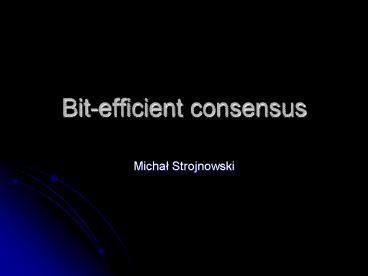Bit-efficient consensus PowerPoint PPT Presentation
Title: Bit-efficient consensus
1
Bit-efficient consensus
- Michal Strojnowski
2
The Byzantine Generals Problem
- n entities
- Each has its value
- They communicate using only point-to-point
messages - The goal is to choose one of this values, and
make it known to everyone
3
The Byzantine Generals Problem
- n entities
- Each has its value
- They communicate using only point-to-point
messages - The goal is to choose one of this values, and
make it known to everyone - Simplest solution one leader sends its value to
everyone
4
Traitors
- In the Byzantine Generals Problem, we assumed any
malicious behavior of traitors - In this case, no protocol is resilient to n/3
such aberrations
5
Traitors
- In the Byzantine Generals Problem, we assumed any
malicious behavior of traitors - In this case, no protocol is resilient to n/3
such aberrations
6
Traitors
- In the Byzantine Generals Problem, we assumed any
malicious behavior of traitors - In this case, no protocol is resilient to n/3
such aberrations
7
Crashes
- Assume that only possible violation of protocol
is a crash (i.e. death of general) - Consensus is possible for any number of crashes,
but still not easy to achieve - t crashes require t1 rounds of communication
- (in asynchronous case problem is unsolvable)
- Most protocols use big number of lengthy messages
8
Lowering the number of messages
- Define a communication graph, and send messages
through it edges. - Ensure that there exists a big, strongly
connected subset of correct nodes - Devise a protocol in which the final value is
easy to obtain
9
Communicators
- Degree of every node is d
- In each subset of 4n/d nodes, there exists a
subset in which each node has k neighbors - Each such subset has at least n/4d vertices
- Each two sets of n/4d vertices are connected
10
Family of communicators
degree d2 diameter (log n)/2
degree d diameter log n
degree n diameter 1
11
Preliminaries
- 1 is a dominant value. Any node that receives 1,
change its own value to 1. - Depending on value, we will call node
- either 1-node or 0-node.
- We will be using only 1-bit messages.
12
Algorithm (case tltn/2)
- Each 1-node sends its value to its neighbors. If
less than k nodes reply, it switches to the next
communicator. - After log n rounds of communication without
switching, node makes its decision. After that,
it only answers to received messages. - 0-nodes start the same procedure t2log n rounds
later
13
Analysis
- Why wait t rounds?
14
Analysis
- Why wait t rounds?
15
Analysis
- Why wait t rounds?
16
Analysis
- Why wait t rounds?
17
Analysis
- Why wait t rounds?
18
Analysis
- Why wait t rounds?
19
Analysis
- If all 1-nodes die out, the final decision is 0
- If not, in any round without failure,
neighborhood of - 1-nodes expands k/2 times, until it reaches size
n/2 - Any node eventually communicates with the set of
- 1-nodes.
- Every node sends O(log2n) messages before making
its decision. - For tgtn/2, we use sequence of log n epoches.
20
Conclusions
- It is possible to achieve consensus in tO(log2n)
rounds, using messages of total length O(n log3n)
bits.

